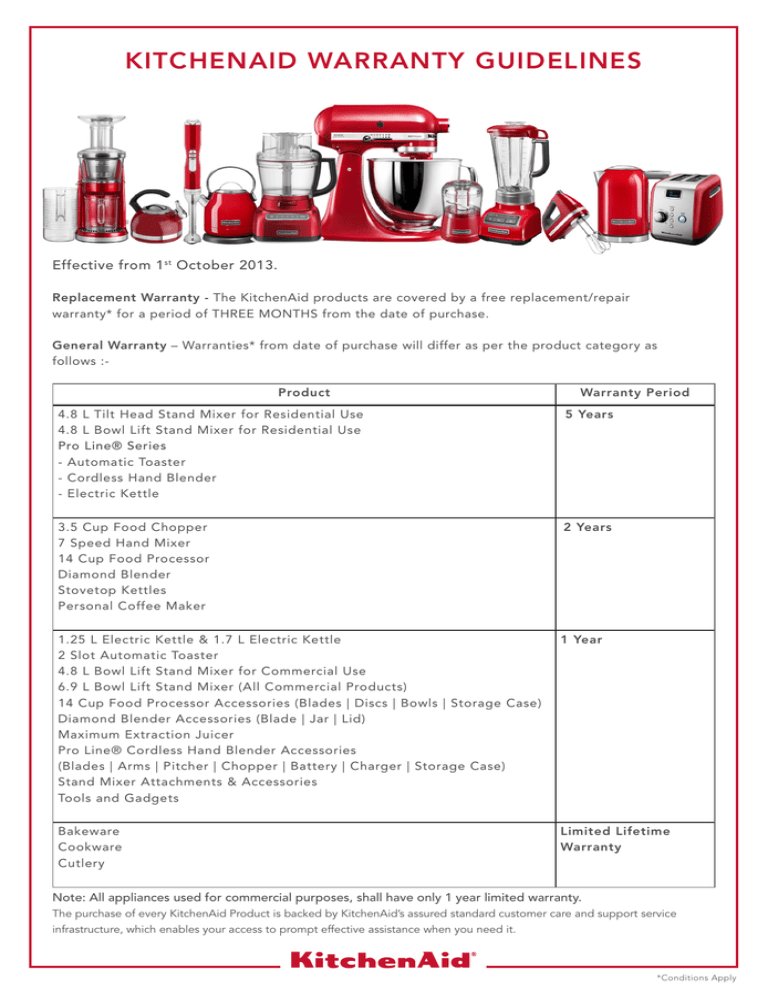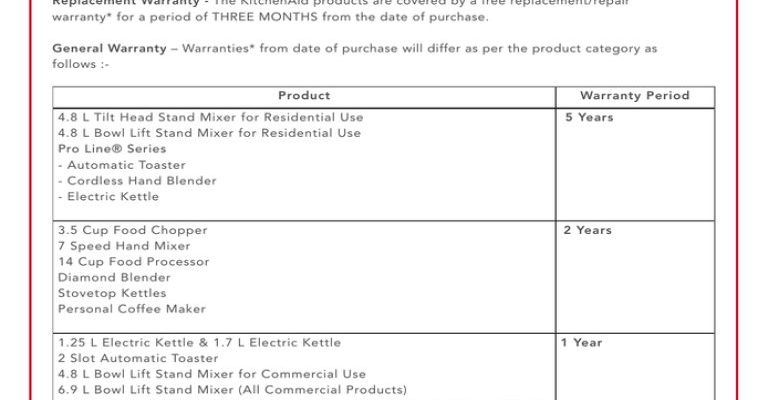
If you’ve just unboxed your KitchenAid kitchen appliance and spotted that little card in the packaging or saw a “Register your product!” prompt online, you might be wondering: *Do I actually have to register my warranty to make a claim if something goes wrong?* Or is it just one of those extra steps brands throw in to collect your info? Let me explain what actually matters—without the confusing legal jargon, intimidating forms, or mystery fees.
What Does Warranty Registration Really Mean?
Let’s start by breaking down what *warranty registration* actually involves. When you buy a new KitchenAid kitchen appliance—maybe a mixer, a fridge, or a coffee maker—there’s almost always an insert or an online prompt asking you to “register your product” for warranty purposes. The idea is pretty simple: you enter details about your new appliance, like the model number, serial number, and your personal info, either on a paper card or through KitchenAid’s website.
Honestly, it feels a bit like syncing your TV remote—an extra step that’s supposed to make life easier, but sometimes just adds to the confusion. Brands say it’s meant to “activate” the warranty, provide faster support, and keep you informed about recalls or troubleshooting tips. But here’s the thing: many folks skip this step and still wonder if they’re missing out on essential protection.
Does Warranty Registration Affect Your Right To Make A Claim?
Now for the real question—*is warranty registration actually required to make a claim* on your KitchenAid appliance? The short, honest answer is: **No, it’s not absolutely required**. U.S. consumer laws generally say that manufacturers can’t deny you warranty service just because you didn’t register your product. It’s a bit like not pairing your universal remote to your TV—you can still use the TV’s buttons; you just might miss out on some extra features or convenience.
When you make a warranty claim, the main things KitchenAid (and most appliance makers) care about are:
- Proof of purchase (your receipt or order confirmation)
- Product model and serial number
If you can provide these, you’re usually good to go—even if that little registration card is still sitting at the bottom of your junk drawer. Registration is mostly about making things smoother and faster—not about *unlocking* your right to claim.
Insight: Warranty registration is more like setting up an account on your favorite streaming app—it’s helpful for extra perks and easier support, but it’s not required to watch your favorite shows (or, in this case, to get your appliance fixed).
Reasons You Might Still Want To Register Your KitchenAid Appliance
You might be thinking, “If registration’s not essential, why bother?” Here’s where it gets practical. Registering your KitchenAid appliance can definitely make life easier in a few ways:
- Smoother warranty claims: If you ever need support, all your info is already in their system. No hunting down old receipts or hunting for serial numbers with a flashlight.
- Quicker troubleshooting: Registered products sometimes get faster troubleshooting help—think pre-filled forms and less waiting on hold.
- Recall notifications: If there’s ever a safety recall or important update, KitchenAid can reach you directly. No more finding out too late via word of mouth.
- Upgrade and accessory offers: You might get exclusive deals or accessory offers, like a new beater blade for your trusty mixer.
So while it’s not required to *make a claim*, registration can save you a lot of time and hassle if something goes wrong. Think of it as resetting your phone to factory settings before reselling—it’s not strictly required, but it makes everything easier if you ever need to revisit it.
What If You Lose Your Receipt Or Didn’t Register?
Maybe you tossed your receipt with the packaging, or you completely missed the registration step (hey, it happens!). The good news is, *you’re not out of luck*. Here’s what usually helps:
- Look for digital proof: If you ordered online, dig into your email for an order confirmation. KitchenAid almost always accepts digital receipts for warranty claims.
- Find the serial number: Most KitchenAid appliances have this etched or printed on the back, bottom, or inside panel. This number is your device’s fingerprint—it’ll help the support team verify your unit and troubleshoot as needed.
- Contact KitchenAid support: Even if you didn’t sync things up with a registration form, customer service can often help you recover proof of purchase, especially if you bought directly from them or a major retailer.
It’s a little like trying to pair an unbranded remote with your TV—there’s always a workaround if you know where to look, even if you skipped the official steps.
How To Register Your KitchenAid Appliance (If You Want To)
Let’s say you decide you *do* want to register your appliance for peace of mind. The process is refreshingly simple—no secret codes, no need to reset anything. Here’s how it typically works:
- Visit the KitchenAid official website.
- Find the “Product Registration” section (usually in the support, warranty, or help menu).
- Enter your appliance’s info—model number, serial number, and purchase date.
- Add your contact details—name, address, email, maybe your phone number.
- Submit the form and keep any confirmation email for your records.
It’s a quick two-minute job, and you’ll feel better knowing your info’s on file. And if you ever need to sync up your support call with KitchenAid, you’ve already done the prep work.
Comparing KitchenAid’s Policy With Other Appliance Brands
You might be curious if KitchenAid is unusual for not demanding warranty registration. In reality, this is pretty standard in the kitchen appliance world. Big names like Whirlpool, GE, Samsung, and LG all recommend—*but don’t require*—product registration for warranty claims.
The “code” all these brands tend to follow is about proof of purchase, not registration. That’s good news for anyone who dreads paperwork or worries about missing a deadline. Think of registration as an optional battery backup: helpful, but not required for the appliance to run or for support to *kick in* when you need it.
Where you sometimes run into trouble is with third-party sellers, refurbished units, or international warranties. In those cases, documentation (including registration) can be more important for troubleshooting or making claims. But for brand-new KitchenAid products bought from an authorized retailer, registration is an *extra*, not a necessity.
What About Extended Warranties Or Service Plans?
Here’s something a lot of folks overlook: KitchenAid’s standard manufacturer warranty is one thing—but if you’ve bought an extended warranty or service plan, the rules can change. Third-party insurance is a bit like using a universal remote instead of your TV’s original—you might need to go through extra steps to “pair” it with your product.
- Register with the provider: If you bought extra coverage from a place like Best Buy or Home Depot, you may need to register the product separately with them. Their “sync” process might be required to activate the plan.
- Check the fine print: Sometimes, these plans have stricter requirements about submitting receipts or registering within a certain window after purchase.
- Keep all documents: Unlike KitchenAid’s leniency, third-party plans aren’t always as flexible about lost receipts or missing registration info.
So while KitchenAid is pretty chill about warranty registration, extended or third-party warranties might pull a harder line—don’t get tripped up by assuming all warranties work the same way.
Helpful Tips For Making Any KitchenAid Warranty Claim
If you ever do need to file a claim—whether your mixer won’t reset, your dishwasher’s having trouble syncing cycles, or your fridge just won’t cool—here’s how to make the process as smooth as possible:
- Gather your proof of purchase and serial number first. This saves you from scrambling when support asks.
- Describe the issue in detail. Explaining the specific problem and any troubleshooting steps you’ve tried (“I unplugged it, I tried resetting the code, nothing worked…”).
- Contact KitchenAid via their official site or helpline. They’ll guide you through the rest, whether you’re registered or not.
- Keep a record of the claim. Save emails, claim numbers, or chat logs in case you need to follow up.
And if you ever feel like you’re hitting a roadblock, don’t be shy about asking for a supervisor or seeking a second opinion—sometimes, support teams miss details, especially if your case is a little unusual.
Wrapping It Up: Registration’s Nice, But Not Required
Making a warranty claim on a KitchenAid appliance isn’t as tricky as it might seem. To answer the big question: **No, warranty registration isn’t required to make a claim—but it does make things easier.** Think of it as adding your favorite show to a “watchlist”—it’s optional, but you’ll thank yourself for it if you ever need quick access.
At the end of the day, your key to successful troubleshooting or warranty coverage is your proof of purchase and your appliance’s serial number. If you’ve got those, you’re prepared for whatever kitchen mishap may come your way—whether it’s a mixer that won’t spin or a coffee maker that refuses to brew before you’ve had your morning cup. Register if you want extra peace of mind, but rest assured, KitchenAid won’t leave you in the lurch if you skip it. Just keep your receipt and enjoy cooking!
